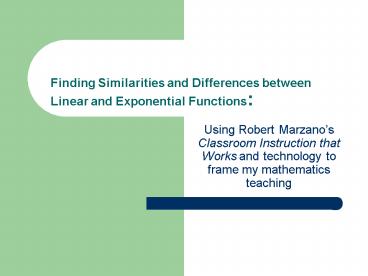Finding Similarities and Differences between Linear and Exponential Functions: - PowerPoint PPT Presentation
1 / 22
Title:
Finding Similarities and Differences between Linear and Exponential Functions:
Description:
Kayla is also proposing an allowance agreement with her parents. ... Find an algebraic formula to represent Kayla's allowance growth over the ten years. ... – PowerPoint PPT presentation
Number of Views:1860
Avg rating:3.0/5.0
Title: Finding Similarities and Differences between Linear and Exponential Functions:
1
Finding Similarities and Differences between
Linear and Exponential Functions
- Using Robert Marzanos Classroom Instruction that
Works and technology to frame my mathematics
teaching
2
Some resources I use to teach this lesson (plus
Excel and TinkerPlots!)
3
Marzanos Nine Best Teaching Practices
4
Background Finding Similarities and Differences
- Identifying Similarities and DifferencesThe
ability to break a concept into its similar and
dissimilar characteristics allows students to
understand (and often solve) complex problems by
analyzing them in a more simple way. Teachers can
either directly present similarities and
differences, accompanied by deep discussion and
inquiry, or simply ask students to identify
similarities and differences on their own. While
teacher-directed activities focus on identifying
specific items, student-directed activities
encourage variation and broaden understanding,
research shows. Research also notes that graphic
forms are a good way to represent similarities
and differences. - Applications Use Venn diagrams or charts to
compare and classify items. Engage students in
comparing, classifying, and creating metaphors
and analogies.
5
Lesson Objectives
- Students will
- Explore real life examples of linear and
exponential functions. - Analyze problem, predict a reasonable outcome,
and generate accurate solutions that make sense
to them. - Communicate and share their ideas on how to solve
the problem given. - First make sense of and then apply the standard
mathematical formulas for linear and exponential
functions to the given situation. - Employ technology to assist and reflect their
understanding of the problems and solutions. - Compare and contrast linear and exponential
functions in terms of concept, graphic
illustration, outcome and mathematical formulas.
6
Assessments
- Students will produce and present a
technology-generated presentation demonstrating
their understanding of how linear and exponential
functions are similar and different. - Students will generate and share formulas
representing both linear and exponential growth. - Teacher will observe students working in groups
to assess conceptual understanding.
7
Washington State Conceptual GLEs addressed in
this lesson
- 1.4.5 Understand and apply data techniques to
interpret bivariate data. - 1.4.6 Evaluate how statistics and graphic
displays can be used to support different points
of view. - 1.5.1 Apply understanding of linear and
non-linear relationships to analyze patterns,
sequences, and situations.
8
Additional 8th grade GLEs
- 1.5.2 Analyze a pattern, table, graph, or
situation to develop a rule. - 1.5.4 Apply understanding of concepts of algebra
to represent situations involving single-variable
relationships. - Plus, this lesson involves problem-solving,
analyzing/reasoning, communicating, and relating
mathematics to the real world! Wow!
9
Some assumptions for this lesson
- This lesson takes place in the latter half of the
8th grade year, over the course of several class
sessions. - Students have already worked with linear
functions. - Students have actively used graphing calculators,
TinkerPlots, Geometers Sketchpad and Excel as
part of their mathematical studies throughout the
year.
10
The Allowance Dilemma
- Jenna is negotiating her allowance with her
parents. Now in the third grade, she earns 5
per week. She proposes that her allowance should
increase by 1.00 each year until she reaches her
senior year of high school.
- Kayla is also proposing an allowance agreement
with her parents. She wants to start earning 5
per week in the third grade and increase her
allowance by 50 each year until her senior year.
Which agreement would you choose?
11
Lesson Flow
- Ask students to predict which agreement would
generate more allowance. - Students then work in partners or groups to
calculate the amount of allowance each girl would
receive in her senior year. - Students share their ideas with the class.
- Teaching point What does it mean to increase by
50 each year?
12
Following discussion, students work to create a
technology-generated T-chart and graph of Jennas
allowance growth.
13
Jennas Allowance over 10 years
Teaching point How can we express this graph in
terms of ymxb?
14
Next Step Kaylas agreement
- Teacher then asks students to create a T-chart of
Kaylas allowance growth over ten years.
15
Kaylas Allowance over 10 Years
Students then create a graph of this data using a
calculator, TinkerPlots, or Geometers Sketchpad.
16
Time for discussion
- How do the results of Jennas and Kaylas
allowance growth compare with your predictions? - What do you notice about Jennas and Kaylas
allowance growth? - Which allowance agreement would YOU want to
makeJennas or Kaylas?
17
Assignment
- Work with a partner or group to compare and
contrast the data and graphs of the two allowance
growth patterns Why are they different? How are
they the same? - Find an algebraic formula to represent Kaylas
allowance growth over the ten years. How would
this compare with the formula used to express
Jennas allowance growth? - Present your findings to the class using
technology.
18
Possible graphic organizers for student use
Venn Diagram
19
Graphic Organizers, continued
T-Chart
20
(No Transcript)
21
Lesson Closure
- Students present their compare/contrast projects
and discuss them as a class. - Final Teaching Point Introduce yabt, the
exponential growth formula. - .And now for more work with exponential
functions!
22
Questions or Comments?
- Suggestions on how can I improve this lesson?
- Any tweaking that needs to be done?
- Your reactions?

